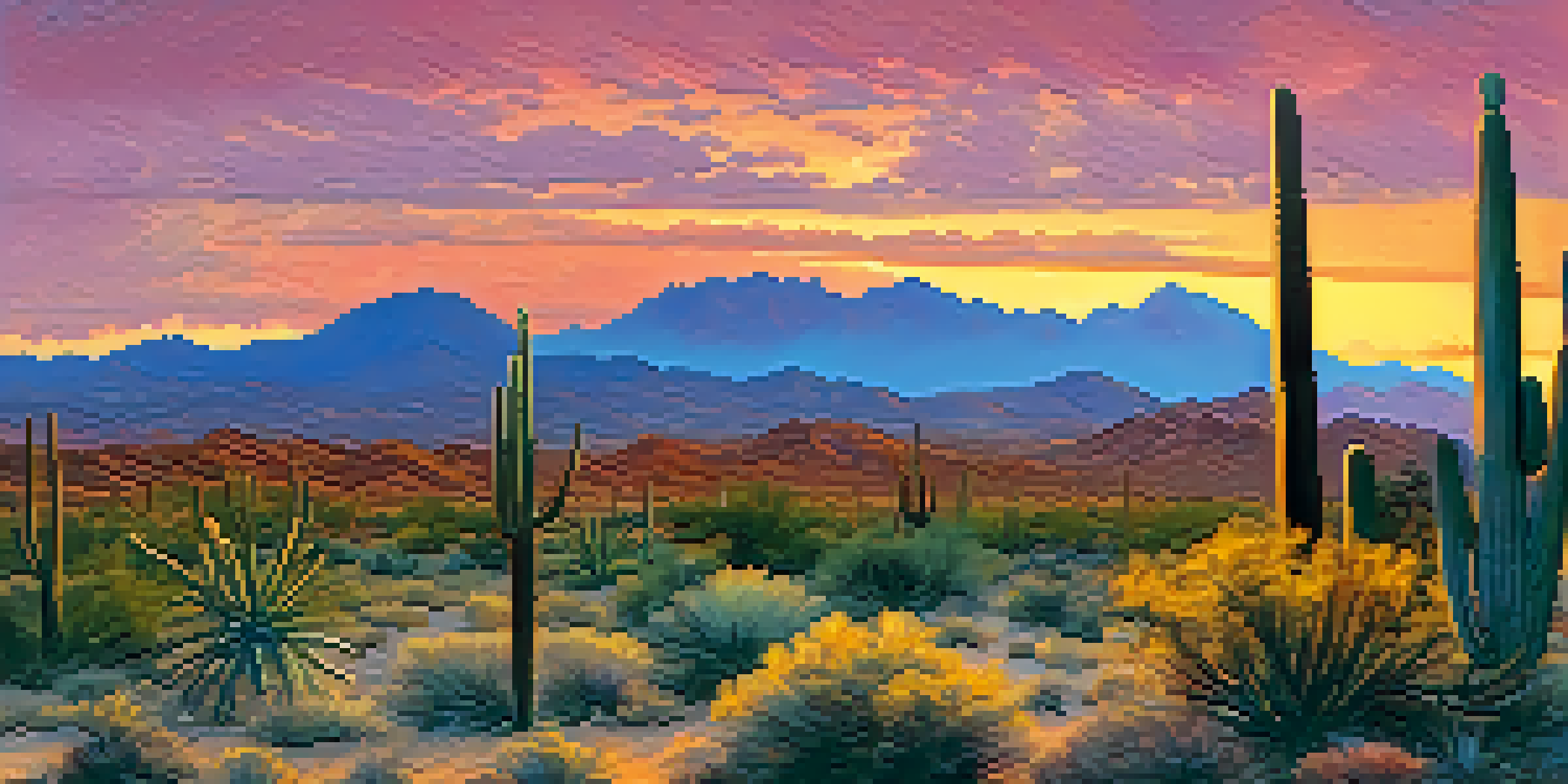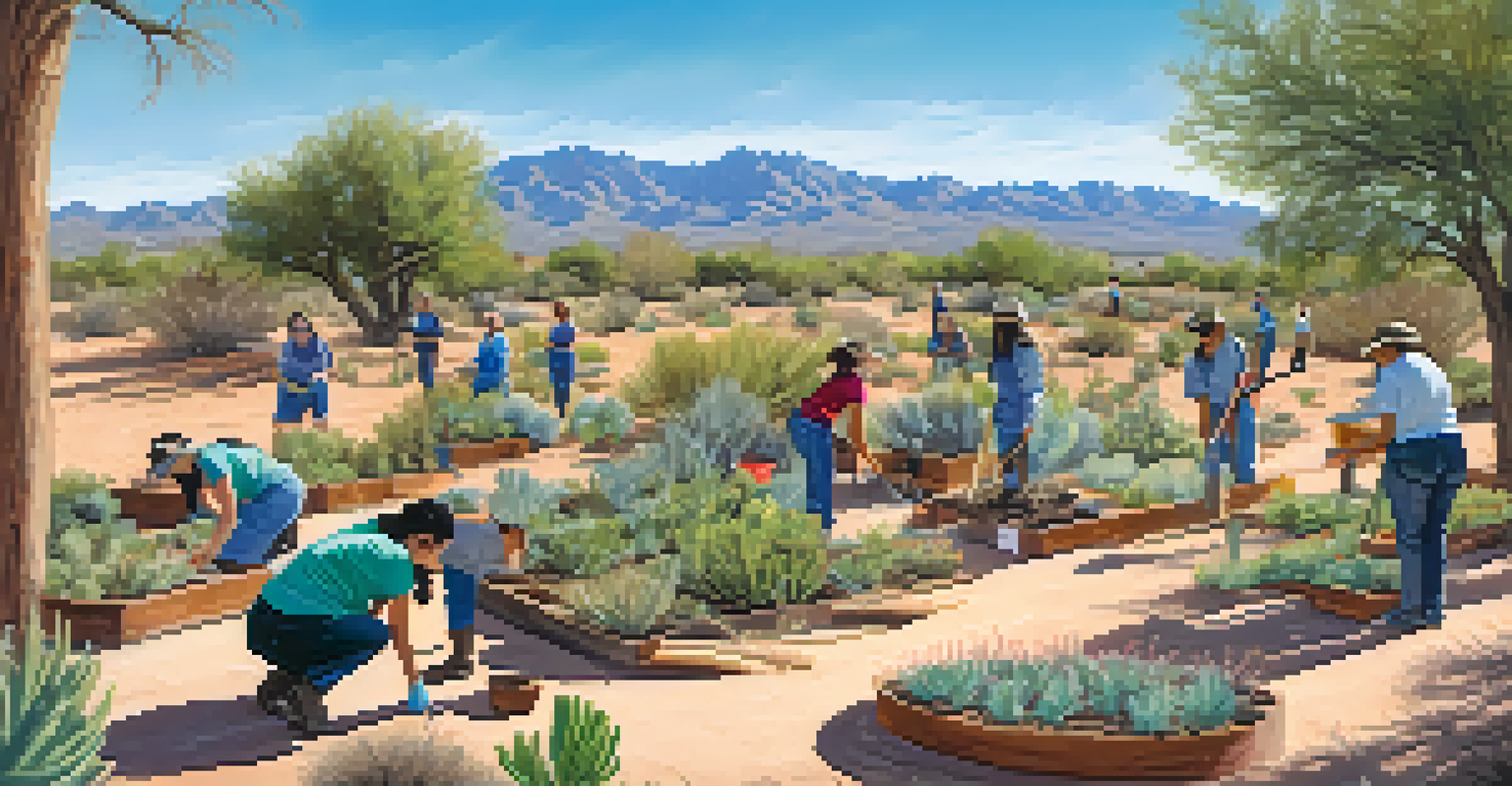Tucson's Role in National Parks Conservation: An Overview

Understanding Tucson's Unique Environment and Biodiversity
Tucson is nestled in the Sonoran Desert, a region recognized for its rich biodiversity. This unique environment is home to various species, including the iconic saguaro cactus and numerous wildlife, making it a hotspot for conservation efforts. The interplay between desert ecosystems and urban development creates both challenges and opportunities for preserving this natural heritage.
In every walk with nature one receives far more than he seeks.
The surrounding landscapes, including mountain ranges and valleys, host a plethora of habitats that support diverse flora and fauna. These areas not only provide essential resources for wildlife but also serve as educational platforms for conservation awareness. By understanding the ecological significance of Tucson, we can appreciate its role in national parks conservation.
Moreover, Tucson's climate and geography create a natural laboratory for studying the effects of climate change on desert ecosystems. Researchers and conservationists utilize this unique setting to develop strategies that can be applied to national parks across the country, showcasing Tucson's pivotal role in broader conservation efforts.
The Impact of Local Organizations on Conservation Initiatives
Numerous local organizations play a vital role in Tucson's conservation landscape. Groups like the Sonoran Desert Conservation Plan and the Tucson Audubon Society work tirelessly to protect natural habitats and promote sustainable practices. Their efforts not only contribute to the preservation of local ecosystems but also align with national conservation goals.

These organizations engage the community through educational programs, volunteer opportunities, and outreach initiatives. By fostering a sense of stewardship among residents, they inspire collective action towards preserving natural spaces. This grassroots approach is crucial for building a culture of conservation that resonates beyond Tucson.
Tucson's Biodiversity is Unique
Tucson's location in the Sonoran Desert fosters a rich diversity of species, making it a critical area for conservation efforts.
Additionally, these organizations often collaborate with national parks and government agencies, amplifying their impact. By sharing research, resources, and expertise, they help shape conservation policies that benefit both local and national priorities, reinforcing Tucson's significance in the larger conservation narrative.
Tucson's Educational Institutions and Their Conservation Efforts
Tucson is home to several educational institutions that are key players in conservation research and education. The University of Arizona, for instance, offers programs focusing on ecology and environmental science, equipping students with the knowledge to tackle conservation challenges. This academic foundation fosters a new generation of conservationists dedicated to preserving natural resources.
The greatest threat to our planet is the belief that someone else will save it.
Moreover, these institutions often partner with local and national parks for research projects. By conducting studies on wildlife populations and habitat health, they contribute valuable data that informs conservation strategies. This collaboration enhances the scientific understanding of ecosystems, benefiting both Tucson's environment and national park conservation efforts.
Educational outreach programs also play a significant role in raising awareness about conservation issues. By engaging students and the community, these initiatives highlight the importance of protecting natural habitats, ensuring that conservation remains a priority for future generations.
The Role of Tucson in Preserving Cultural Heritage
Conservation in Tucson extends beyond the environment to include the preservation of cultural heritage. Indigenous communities have deep connections to the land, and their knowledge is invaluable in conservation efforts. Recognizing and respecting these cultural ties is essential for fostering inclusive conservation practices.
Tucson's rich history is reflected in its art, architecture, and traditions, all of which are integral to its identity. By incorporating cultural heritage into conservation strategies, Tucson can create a holistic approach that values both natural and human histories. This connection enriches the conservation narrative and strengthens community ties.
Local Organizations Drive Change
Community organizations play a pivotal role in conservation by promoting sustainable practices and engaging residents in environmental stewardship.
Furthermore, initiatives that celebrate and preserve cultural heritage often engage local residents, creating a shared sense of responsibility for conservation. This community involvement not only enhances the effectiveness of conservation efforts but also promotes a deeper appreciation for the diverse histories that shape Tucson.
Challenges Facing Tucson's Conservation Efforts
Despite Tucson's proactive stance on conservation, there are significant challenges that need to be addressed. Urban sprawl and development threaten natural habitats, leading to habitat fragmentation and loss of biodiversity. Balancing growth with conservation efforts is a delicate task that requires careful planning and community engagement.
Water scarcity is another pressing issue in Tucson, especially in arid regions like the Sonoran Desert. As populations grow, the demand for water increases, putting additional stress on local ecosystems. Conservationists must develop innovative strategies to manage water resources sustainably, ensuring that both people and wildlife can thrive.
Climate change also poses a significant threat to Tucson's ecosystems. Rising temperatures and shifting weather patterns can disrupt the delicate balance of desert habitats. Addressing these challenges requires collaboration among various stakeholders, including government agencies, non-profits, and the community, to create resilient conservation strategies.
Community Engagement and Volunteerism in Conservation
Community engagement is a cornerstone of Tucson's conservation efforts. Local residents are encouraged to participate in volunteer programs that focus on habitat restoration, wildlife monitoring, and educational outreach. This hands-on involvement fosters a sense of ownership and responsibility toward local natural resources.
Events like park clean-ups and native planting days not only improve local environments but also strengthen community bonds. Volunteers often become advocates for conservation, sharing their experiences and encouraging others to get involved. This ripple effect amplifies the impact of conservation initiatives throughout Tucson.
Education Fuels Conservation Efforts
Educational institutions in Tucson are crucial in preparing future conservationists and conducting vital research that supports local and national conservation strategies.
Furthermore, community engagement initiatives often highlight the importance of sustainable practices in daily life. By educating residents about the benefits of conservation, such as reduced water usage and native landscaping, Tucson is cultivating a culture that prioritizes environmental stewardship.
Future Directions for Tucson's Conservation Efforts
Looking ahead, Tucson's conservation efforts must adapt to an ever-changing landscape. Embracing innovative technologies, such as remote sensing and data analytics, can enhance our understanding of ecosystems and inform decision-making. These advancements will enable conservationists to respond more effectively to emerging challenges.
Additionally, fostering stronger partnerships between local organizations, educational institutions, and government agencies will be crucial. Collaborative efforts can pool resources and expertise, leading to more comprehensive conservation strategies. This united front will enhance Tucson's ability to address both local and national conservation goals.

Finally, continuous community involvement will be essential for the success of future conservation initiatives. Encouraging residents to participate in ongoing dialogue about conservation priorities ensures that efforts remain aligned with community values. By nurturing this collaborative spirit, Tucson can pave the way for a sustainable and resilient future.